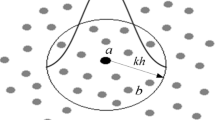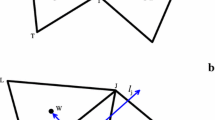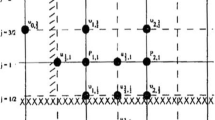Abstract
In this paper, a new advection algorithm is presented to model free surface flows using volume of fluid method. To model the fluid flow, Navier–Stokes equations are solved as governing equations using two-step projection method on the Cartesian staggered grids. In the volume of fluid method, several algorithms such as flux-corrected transport (FCT) and Youngs’ algorithms are used to model the free surface. In these methods, for staggered grids, fluxes to neighboring cells are estimated based on cell face velocities. It means that fluid particles in the cell have the same velocity of the cell faces. However, in practice, the particles velocity varies between two adjacent cell faces velocities. In the present research, modified Youngs’ and flux-corrected transport methods are presented. In these methods, the velocity in mass center of fluid cell is estimated and used to calculate cell face fluxes. The performance of the modified schemes has been evaluated using a number of alternative schemes taking into account translation, rotation, shear test and dam break on dry bed. The results showed that the modified Youngs’ method is more accurate than the original one particularly in coarse grid. It is also more accurate than the modified flux-corrected transport method.













Similar content being viewed by others
Abbreviations
- t :
-
Time (s)
- V :
-
Velocity vector (m2/s)
- p :
-
Hydrodynamic pressure (N/m2)
- ν :
-
Kinematic fluid viscosity (m2/s)
- g :
-
Gravity acceleration (m/s2)
- F :
-
Scalar function of VOF method
- \( U^{n} \) :
-
Velocity field in old time level (m/s)
- \( \hat{U} \) :
-
Intermediate velocity field (m/s)
- \( U^{n + 1} \) :
-
New velocity field (m/s)
- \( {\text{conv}}^{n} \) :
-
Convection term
- \( {\text{Diff}}^{n} \) :
-
Diffusion term
- \( B^{n} \) :
-
Body force including gravity acceleration
- dx :
-
Mesh sizes in the x direction
- dy :
-
Mesh sizes in the y direction
References
Aristoff JM, Bush JWM (2009) Water entry of small hydrophobic spheres. J Fluid Mech 619:45–78
Aristoff JM, Truscott TT, Techet AH, Bush JWM (2010) The water entry of decelerating spheres. Phys Fluids, Vol 22
Burnner B, Tryggavson G (1999) Direct numerical simulation of three dimensional bubbly flow. Phys Fluids (Lett) 111:1967–1969
Carneiro JNE, Fonseca R Jr, Ortega AJ, Chucuya RC, Nieckele AO, Azevelo LFA (2011) Statistical characterization two-phase slug flow in a horizontal pipe. J Braz Soc Mech Sci Eng XXXIII(1):251–258
Do-Quang M, Amberg G (2010) Numerical simulation of the coupling problems of a solid sphere impacting on a liquid free surface. Math Comput Simul 80:1664–1673
Duff ES (1999) Fluid flows aspects of solidification modeling: simulation of low pressure Die casting. PhD thesis, University of Queensland, Brisbane
Geuyffier D, Li J, Nadim A, Scardovelli R, Zaleski S (1999) Volume- of fluid interface tracking with smoothed surface stress methods for three dimensional flows. J Comput Phys 152:423–456
Ghia U, Ghia KN, Shin CT (1982) High-Re solutions for incompressible flow using the Navier–Stokes equations and a multigrid method. J Comput Phys 48:387–411
Guizien K, Barthélemy E (2000) Short waves modulations by large free surface solitary waves: experiments and models. Phys Fluids 13:3624–3635
Harvie DJE, Fletcher DF (2000) A new volume of fluid advection algorithm: the stream scheme. J Comput Phys 162:1–32
Harvie DJE, Fletcher DF (2001) A new volume of fluid advection algorithm: the defined donating region scheme. Int J Numer Methods Fluid 35:151–172
Hirt CV, Nichols BD (1981) Volume of fluid (VOF) method for the dynamics of free boundaries. J Comput Phys 39:201–225
Ketabdari MJ, Nobari MRH, Moradi Larmaei M (2008) Simulation of waves group propagation and breaking in coastal zone using a Navier–Stokes solver with an improved VOF free surface treatment. Appl Ocean Res 30:130–143
Ketabdari MJ, Saghi H (2011) Large eddy simulation of laminar and turbulent flow on collocated and staggered grids. ISRN Mech Eng 2011, Article ID 809498. doi:10.5402/2011/809498
Lafaurie B, Nardone C, Scardovelli R, Zaleski S, Zanetti G (1994) Modeling merging and fragmentation in multiphase flows with SURFER. J Comput Phys 113:134–147
Martin JC, Moyce WJ (1952) An experimental study of the collapse of liquid columns on a rigid horizontal plane. Philos Trans R Soc Lond 244:312–324
Nakayama T, Washizu K (1984) Boundary element analysis of nonlinear sloshing problems. In: Bauerjee PK, Mukherjee S (eds) Developments in boundary element method, vol 3. Elsevier Applied Science Publishers, New York
Nichols BD, Hirt CW, Hotchkiss RS (1980) SOLA-VOF: a solution algorithm for transient fluid flow with multiple free boundaries. Technical Report LA-8355, Los Alamos Scientific Laboratory
Nobari MRH, Ketabdari MJ, Moradi Larmaei M (2009) A modified volume of fluid advection method for uniform Cartesian grids. Appl Math Model 33:2298–2310
Noh WF, Woodward P (1982) SLIC (simple line interface calculation). In: van Dooren A, Baines MJ (eds) Lecture notes in physics, vol 59. Springer, New York, pp 273–285
Pasandideh-Fard M, Roohi E (2008) Transient simulations of cavitating flows using a modified volume-of-fluid (VOF) technique. Int J Comput Fluid Dyn 22:97–114
Renouard DP, Seabra-Santos FJ, Temperville AM (1985) Experimental study of the generation, damping and reflection of a solitary wave. Dyn Atm Oceans 9:341–358
Rider WJ, Kothe BD (1998) Reconstructing volume tracking. J Comput Phys 141:112–152
Rubens C, Julio M, Sérgio Said M, Aristeu da Silveira N (2009) Computations of the flow past a still sphere at moderate Reynolds numbers using an immersed boundary method. J Braz Soc Mech Sci Eng 31(4):344–352
Rudman M (1997) Volume-tracking methods for interfacial flow calculations. Int J Numer Methods Fluids 24:671–691
Scardovelli R, Zaleski S (2000) NOTE: analytical relations connecting linear interfaces and volume fractions in rectangular grid. J Comput Phys 164:228–237
Scardovelli R, Zaleski S (2003) Interface reconstruction with least-square fit and split Eulerian–Lagrangian advection. Int J Numer Methods Fluids 41:251–274
de Lima e Silva AF, da Silva AR, da Silveira Neto A (2007) Numerical simulation of two-dimensional complex flows around bluff bodies using the immersed boundary method. J Braz Soc Mech Sci Eng 29(4):379–387
da Silva AR, da Silveira Neto A, de Lima AMG, Alves Rade D (2011) Numerical simulation of flows over a rotating circular cylinder using the immersed boundary methods. J Braz Soc Mech Sci Eng XXXII(1):99–106
Torrey MD, Cloutman LD, Hirt CW (1985) NASA-VOF2D: a computer program for incompressible flows with free surface. Technical report LA-10462-MS, Los Alamos Scientific Laboratory
Yang J, Stern F (2009) Sharp interface immersed-boundary/level-set method for wave body interactions. J Comput Phys 228:6590–6616
Youngs DL (1985) Time-depend multi-material flow with large fluid distortion. In: Morton KW, Baines MJ (eds) Numerical methods for fluid dynamics. Academic Press, New York, pp 273–285
Author information
Authors and Affiliations
Corresponding author
Additional information
Technical Editor: Francisco Cunha.
Rights and permissions
About this article
Cite this article
Ketabdari, M.J., Saghi, H. Development of volume of fluid methods to model free surface flow using new advection algorithm. J Braz. Soc. Mech. Sci. Eng. 35, 479–491 (2013). https://doi.org/10.1007/s40430-013-0045-7
Received:
Accepted:
Published:
Issue Date:
DOI: https://doi.org/10.1007/s40430-013-0045-7




